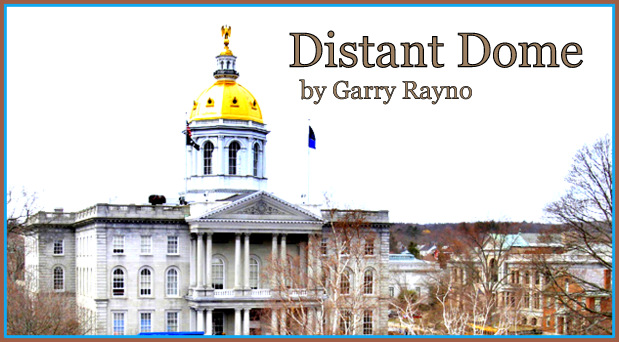
By GARRY RAYNO, InDepthNH.org
State government budgets are all about priorities: What is important to the majority party.
While the state is just over a quarter of the way through the current biennial (two-year) budget, some caution flags are being hoisted about future revenue shortfalls.
The latest revenue figures through the end of January, show state collections stand at $1.48 billion, which is $108.1 million more than budget-writer estimates needed for a balanced budget, and $52.1 million more than fiscal year 23, which had a record $518 million revenue surplus.
What are the concerns then with still good financial numbers halfway through the 2024 fiscal year budget?
The biggest driver of recent record setting revenue surpluses has been business taxes, fueled largely by large multinational corporations who benefited greatly from the massive amounts of government money poured into the nation’s economies to combat the economic drag of the COVID-19 pandemic through closings, workforce issues and supply chain breakdowns.
For February, business tax collections for the state were $4 million below estimates, producing $57.6 million instead of the estimate of $61.1 million. The shortfall was due to a deficit of $5.8 million in business enterprise tax collections.
The BET is often more reflective of the state’s economy than the business profits tax, which reflects more the national and international economies, which had a $1.8 million surplus.
But the problem according to the Department of Revenue Administration is two-fold, a large increase in refunds (businesses paid too much into the state in estimates last year) and reduced estimate payments this fiscal year with businesses not expecting to do as well as they did the last few years.
The problem is compounded by a new law limiting the amount of tax credits to 500 percent a company can hold for future payments, which meant a number of companies had refunds for having more than the new threshold which accounted for 43 percent of the refunds, according to the DRA.
The other big shortfall was in the real estate transfer tax which was off by $3.5 million in January and $29.2 million for the year.
The number of sales was down 8.4 percent and the value was down 5.1 percent.
So given the concern for some key revenue raises for the state, why did the chair of the House Finance Committee, Rep. Ken Weyler, R-Kingston, waive review of House Bill 1665, which expanded the salary cap for the Education Freedom Account (voucher) program?
First and foremost, the bill passed by one vote, after two other EFA expansion bills were voted down. Sending it to Finance means the opposition would have another chance to kill it when a final vote is taken, but instead it is now before the Senate.
Secondly, the bill expands the salary cap from 350 percent of federal poverty to 500 percent increasing the cap for a family of four from $109,500 to $156,000 which would mean about 63 percent of the families in the state with school-age children would be eligible for vouchers averaging over $5,000 per student.
Although the state Department of Education said it could not tell how many children would decide to participate, Reaching Higher NH, using census data says the program could cost $66 million next fiscal year if — as has been the case here and elsewhere — many parents of students currently in private and religious schools, and in homeschooling programs seek state funded subsidies.
The $66 million is $42 million more than the projected costs this fiscal year and $36 million more than budgeted for the program this fiscal year and next.
Maybe the House Republican leadership did not want to give those figures any light.
The money for the EFA program comes from the Education Trust Fund, which was established about 25 years ago to pay the adequacy aid to school districts after the Claremont education decisions by the state Supreme Court.
For most of its lifetime, the fund ran a deficit and general fund money had to be added to cover the cost of adequacy aid to school districts.
However, the past five or six years, the fund has had a surplus with the number of students declining and the legislature not adding, in fact, cutting school aid until the 2019 budget.
Currently the trust fund has about a $200 million surplus that many targeted as a start to addressing two recent court decisions on the education funding program telling the state it is underpaying to provide an adequate education for the state’s students and shifting the burden to local property taxes making it unconstitutional because state taxes have to be “proportional and reasonable.”
The court also said the state’s methodology in administering the Statewide Education Property Tax is unconstitutional as well.
But Weyler proposed a bill, that also passed Thursday, that would move any surplus at the end of the biennium into the general fund, which is likely to mean into the rainy day fund.
By doing that and increasing EFA money by $42 million, the fund could soon be running at a deficit again and the pressure would be on to cut education costs.
The two court rulings could cost the state about $532 million annually if lawmakers decide to act on the orders, which is unlikely this session or even next session.
There are other issues that need to be addressed such as the state retirement system changes for Group 2 (law enforcement and firefighters) which were short changed when the system was overhauled a decade ago.
That true up could cost about $50 million.
There is always the issue of Medicaid reimbursement rates which were increased in the current budget, but not enough for some of the providers who cannot find workers to fill positions even with the increase in rates.
The federal pandemic money is about at its end, and money will have to be found for child care services, one of the keys to putting people back in the workforce.
The state is building a new youth detention center on the grounds of Hampstead Hospital, but budget officials were told last month it may be too small when it opens and may need to be expanded.
The Highway Fund is running short with more efficient vehicles and electric vehicles that do not pay the gas tax.
The Fish and Game agency has needed general fund money for the past few years as has the self-funded state park system.
There are a lot of needs, but the House and the Senate is likely to go along, as some are saying the priority is new education subsidies for parents earning less than $156,000 a year, 75 percent of it targeted to private and religious school tuition and homeschooling costs.
That is about 11 percent of the students in the state, while the other 89 percent continue going to public schools, whose quality depends largely on the relative wealth of the community and its proximity to the ocean or large lakes.
There is an organization that recently touted its success at electing state lawmakers who favor voucher programs called Young Americans for Liberty, which grew out of Ron Paul’s last presidential campaign.
Its sister organization of state lawmakers is called the Hazlitt Coalition, among its members are seven GOP members of the House Education Committee.
The total number of state legislative members nationwide of Hazlitt is 320, of which 95 are members of the New Hampshire legislature, 93 GOP House members, and two GOP state Senators.
In a press release, the YAL touted it had about $13 million in dark money it intends to use to increase the number of state lawmakers favoring voucher programs.
According to The Capital Center’s Influence Watch, known contributors to YAL include the Americans for Prosperity Foundation, the Chase Foundation of Virginia and the Charles Koch Foundation.
The groups’ investment has already been returned by the New Hampshire legislature.
Garry Rayno may be reached at garry.rayno@yahoo.com.
Garry Rayno may be reached at garry.rayno@yahoo.com. Distant Dome by veteran journalist Garry Rayno explores a broader perspective on the State House and state happenings for InDepthNH.org. Over his three-decade career, Rayno covered the NH State House for the New Hampshire Union Leader and Foster’s Daily Democrat. During his career, his coverage spanned the news spectrum, from local planning, school and select boards, to national issues such as electric industry deregulation and Presidential primaries. Rayno lives with his wife Carolyn in New London.






